How to Tell if a Cat Is a Russian Blue

Table of Contents
- 1. What Makes Russian Blues So Special?
- 1.1. What is a Russian Blue and How Did It Originate?
- 1.2. Why are Russian Blues so Popular Among Cat Owners and Breeders?
- 2. How to Recognize a Russian Blue by Its Appearance
- 3. Russian Blue Cat Identification: FAQ
- 3.1. What Cat Is Mistaken for a Russian Blue Cat?
- 3.2. How to Tell the Difference Between Russian Blue and Domestic Shorthair?
- 3.3. How Do You Identify a Russian Blue Cat?
- 4. Conclusion
As a cat lover, you've probably heard of the Russian Blue, one of the most elegant and charming breeds of cats. But how can you tell if a cat is a Russian Blue, and not just a regular gray cat? That's what this article will help you find out.
How to tell if a cat is a Russian Blue is not as simple as it may seem. There are many factors that you need to consider, such as the coat color and texture, the eye color and shape, and the body shape and size.
What Makes Russian Blues So Special?
Among the many breeds of cats, there is one that stands out for its beauty, grace, and charm: the Russian Blue cat. This breed has a unique history, appearance, and personality that make it a desirable and delightful companion for cat lovers.
But what makes Russian Blues so special, and how can you tell if a cat is a Russian Blue?
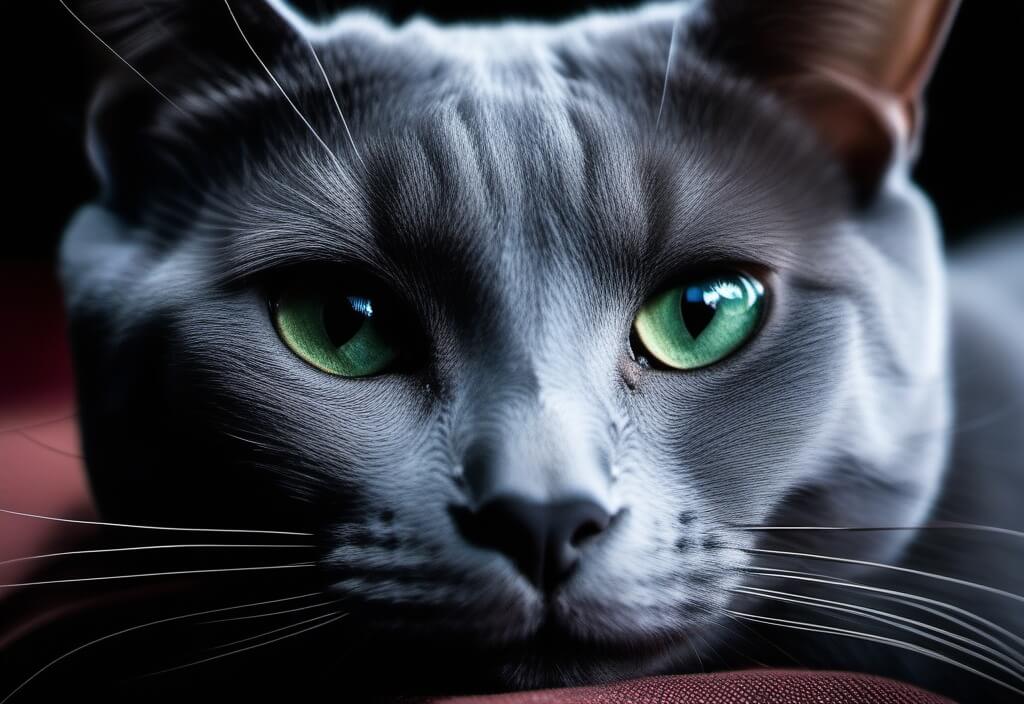
What is a Russian Blue and How Did It Originate?
The Russian Blue cat is a natural breed that originated in the port city of Arkhangelsk, Russia, also known as Archangel. They are believed to have been brought to Europe by sailors in the 1800s, and were first exhibited in England in 1875.
Russian Blue cats were called Archangel cats, Foreign Blues, or Maltese cats, before they were officially recognized as Russian Blues in 1912.
The Russian Blue cat has a distinctive appearance that sets it apart from other breeds. They have a short, dense, and plush coat that is silvery-blue in color, with a shimmering effect.
These cats have large, almond-shaped eyes that are vivid green, and a wedge-shaped head with large ears and a straight nose. They have a slender, muscular, and graceful body, with long legs and a long tail.
The Russian Blue cat is a natural breed that originated in Russia and has a distinctive silvery-blue coat and green eyes.
Why are Russian Blues so Popular Among Cat Owners and Breeders?
The Russian Blue cat is not only a beautiful breed, but also a loyal, intelligent, and affectionate one. They are known for their gentle and sweet temperament, and their ability to bond with their owners.
This breed is also very playful and curious, and enjoys interactive toys and games. These cats are not very vocal, but they will communicate with their owners through subtle sounds and body language.
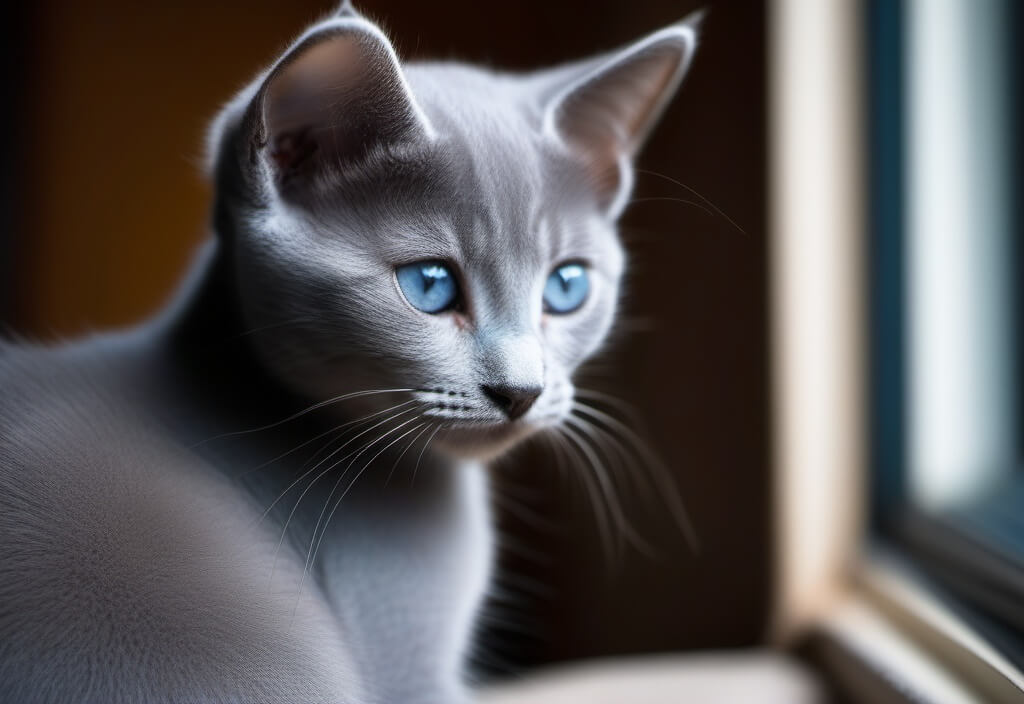
The Russian Blue cat is also a low-maintenance breed, as they do not shed much and require minimal grooming. They are also very clean and hygienic, and will keep themselves and their surroundings tidy.
Russian Blue cats are also very healthy and robust, and have a long lifespan of up to 20 years.
The Russian Blue cat is a loyal, intelligent, and affectionate breed that is easy to care for and has a long lifespan.
How to Recognize a Russian Blue by Its Appearance
The most important aspect of identifying a Russian Blue cat is their appearance. Russian Blues have some distinctive features that make them stand out from other breeds of cats.
But they also have some similarities with other cats that can cause confusion and misidentification. In the following, we'll go over the main characteristics of a Russian Blue cat's appearance, and how to tell them apart from other cats.

Coat Color and Texture
The most obvious and striking feature of a Russian Blue cat is their coat color and texture. They have a short, dense, and plush coat that is silvery-blue in color, with a shimmering effect.
The coat is also very soft and silky to the touch, and has a fine texture. The coat color is uniform throughout the body, except for the tips of the hairs, which are slightly darker.
Their coat color may vary slightly depending on the lighting and the angle, but it should always have a bluish hue.
Some cats may have a similar coat color to a Russian Blue, but they usually have a different coat texture or pattern.
For example, some British Shorthairs, Chartreux, and Korats may have a blue-gray coat, but they have a coarser or woollier texture, or a tabby or tortoiseshell pattern.
Some domestic shorthairs may also have a blue coat, but they usually have white patches or markings, or a different eye color.
The coat color and texture of a Russian Blue cat is silvery-blue, shimmering, and soft.
Eye Color and Shape
Russian Blue cats have large, almond-shaped eyes that are vivid green, and a wedge-shaped head with large ears and a straight nose.
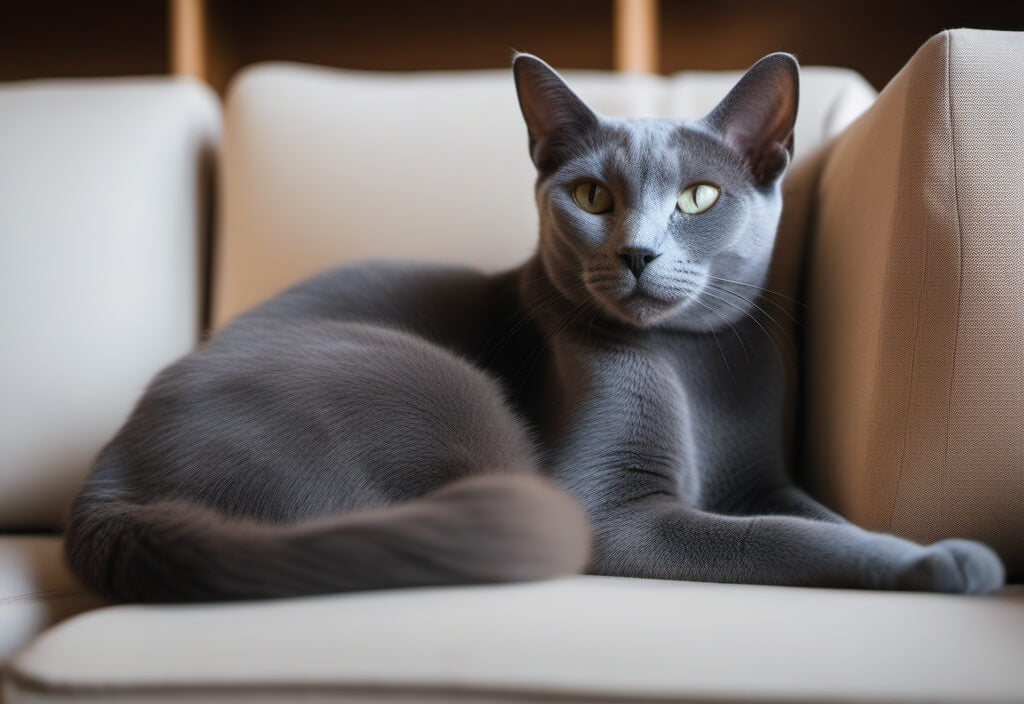
The eyes are set wide apart and slightly slanted, giving them an expressive and alert look. The eye color may vary from light green to dark green, but it should always be bright and clear.
Some cats may have a similar eye color to a Russian Blue, but they usually have a different eye shape or head shape.
For example, some Siamese, Balinese, and Oriental cats may have green eyes, but they have a more pointed head and ears, and a more round or oval eye shape.
Some domestic shorthairs may also have green eyes, but they usually have a more round or square head, and a more round or triangular eye shape.
The eye color and shape of a Russian Blue cat is vivid green, almond-shaped, and slanted.
Body Shape and Size
The final feature of a Russian Blue cat's appearance is their body shape and size. They have a slender, muscular, and graceful body, with long legs and a long tail.
These cats are medium-sized cats, weighing between 7 and 12 pounds, and measuring between 10 and 12 inches at the shoulder.
Russian Blue cats have a fine-boned structure, but they are not fragile or delicate. They have a well-balanced and proportionate appearance, with no extremes or exaggerations.
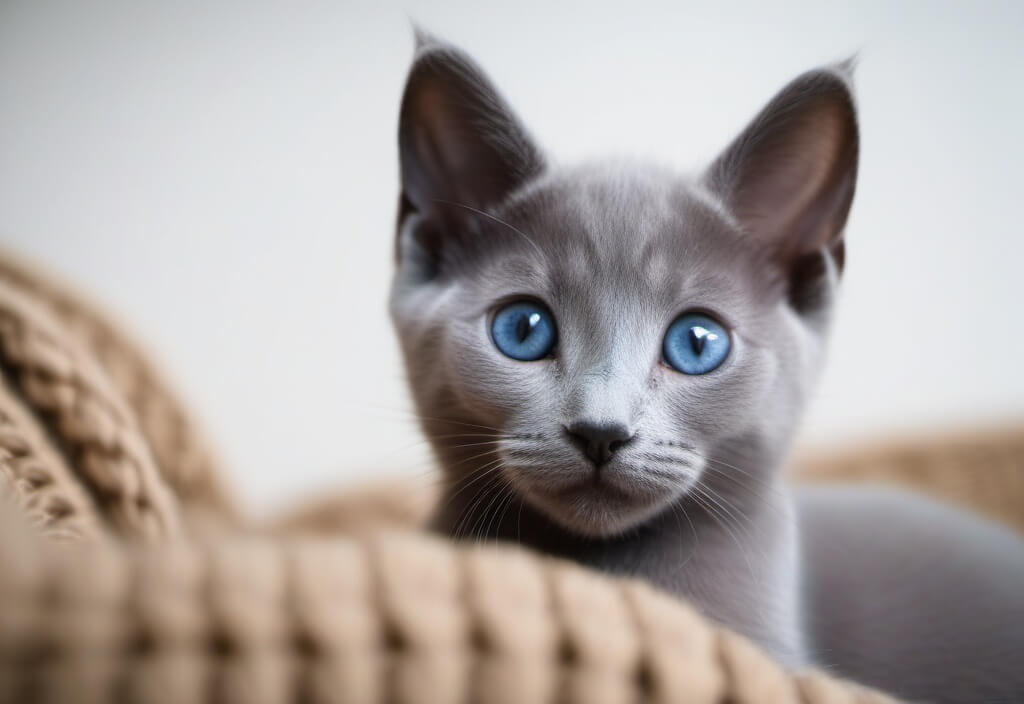
Some cats may have a similar body shape and size to a Russian Blue, but they usually have a different coat color or texture, or a different eye color or shape.
For example, some Abyssinians, Somalis, and Bengals may have a slender and muscular body, but they have a reddish-brown, golden, or spotted coat, and amber, yellow, or brown eyes.
Some domestic shorthairs may also have a medium-sized and well-balanced body, but they usually have a different coat color or pattern, or a different eye color or shape.
The body shape and size of a Russian Blue cat is slender, muscular, and graceful, with long legs and a long tail.
Russian Blue Cat Identification: FAQ
After learning about the appearance and personality of a Russian Blue cat, you may still have some questions about how to identify them from other cats.
Next, we'll answer some of the most frequently asked questions about Russian Blue cat identification, and clear up some common myths and misconceptions.
What Cat Is Mistaken for a Russian Blue Cat?
The most common cat that is mistaken for a Russian Blue cat is a domestic shorthair cat. Domestic shorthairs are not a specific breed, but a mixed-breed category that includes any cat with a short coat and no pedigree.
Some domestic shorthairs may have a blue-gray coat that resembles a Russian Blue, but they usually have different eye colors, body shapes, and coat textures.

Other breeds that may look similar to a Russian Blue are the British Shorthair, Chartreux, and Korat, but they also have distinct differences that can help you tell them apart.
The most common cat that is mistaken for a Russian Blue cat is a domestic shorthair cat.
How to Tell the Difference Between Russian Blue and Domestic Shorthair?
The easiest way to tell the difference between a Russian Blue and a domestic shorthair is to look at their eyes. A Russian Blue cat has vivid green eyes, while a domestic shorthair cat can have any eye color, such as yellow, amber, or brown.
Another way to tell the difference is to look at their coat. A Russian Blue cat has a silvery-blue coat that shimmers and has a fine texture, while a domestic shorthair cat can have a blue-gray coat that is duller and coarser.
You can also tell the difference by looking at their body. A Russian Blue cat has a slender, muscular, and graceful body, while a domestic shorthair cat can have a more round, stocky, or chubby body.
The easiest way to tell the difference between a Russian Blue and a domestic shorthair is to look at their eyes, coat, and body.
How Do You Identify a Russian Blue Cat?
The best way to identify a Russian Blue cat is to look for a combination of features that are unique to this breed. A Russian Blue cat has a silvery-blue coat, green eyes, a wedge-shaped head, large ears, a straight nose, a slender body, long legs, and a long tail.
They also have a gentle and sweet personality, and are loyal, intelligent, and affectionate. But the only way to be sure that a cat is a Russian Blue is to check their pedigree and registration papers, if they have any.
A Russian Blue cat is a purebred cat that has a documented lineage and belongs to a recognized cat association. A cat without papers may be a Russian Blue mix, or a different breed altogether.
The best way to identify a Russian Blue cat is to look for a combination of features that are unique to this breed, and to check their pedigree and registration papers, if they have any.
Conclusion
You've reached the end of this article, and hopefully, you've learned a lot about the Russian Blue cat. This breed is truly one of a kind, with its stunning appearance, charming personality, and loyal companionship.
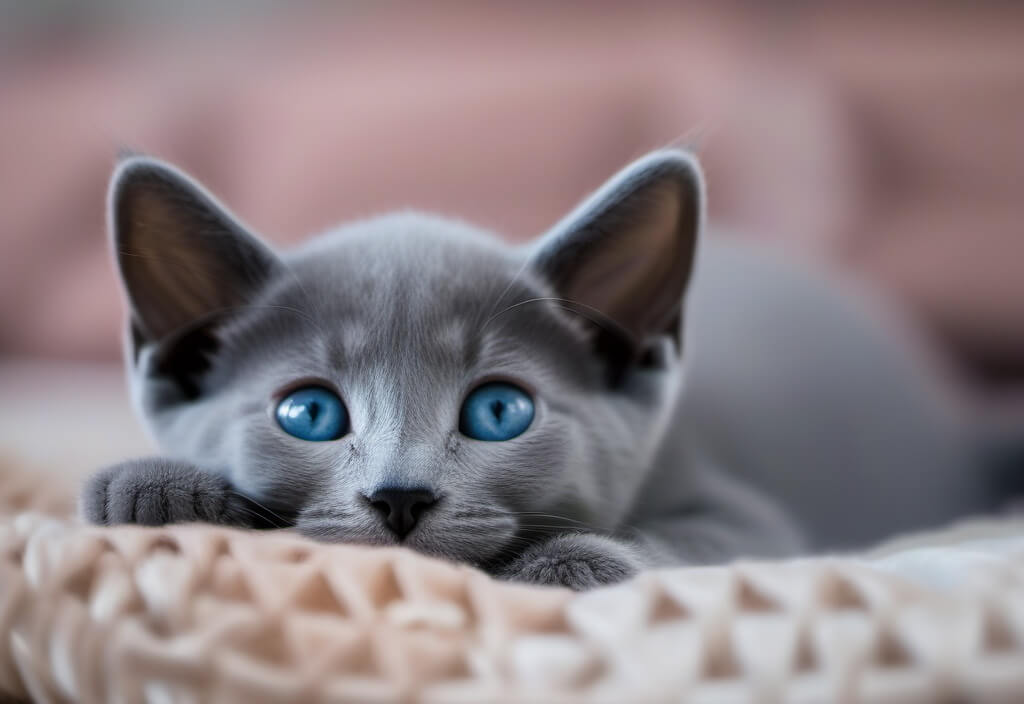
Whether you're looking for a new pet, or just curious about this breed, we hope this article has answered your questions and cleared your doubts.
Here are some key points to remember about the Russian Blue cat:
- They are a natural breed that originated in Russia and have a silvery-blue coat and green eyes.
- They are gentle, sweet, intelligent, and affectionate, and bond well with their owners.
- They are easy to care for, as they do not shed much and are very healthy and robust.
- They can be identified by their combination of features, and by checking their pedigree and registration papers, if they have any.
If you're interested in adopting a Russian Blue cat, make sure to do your research and find a reputable breeder or rescue organization that can provide you with more information and guidance. A Russian Blue cat can be a wonderful addition to your family, and a lifelong friend.
Thank you for reading this article, and we hope you enjoyed it. If you did, please share it with your friends and fellow cat lovers. And if you have any questions or comments, please leave them below. We'd love to hear from you.
Until next time, stay pawsitive and meowtastic!
